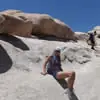Whether you buy or rent an RV there's one important detail to consider: How will you get it from point A to point B? Driving an RV can seem daunting, especially if you normally drive a small, four-door sedan.
So, take a trip back to your teenage years, remember the first time you sat in the driver's seat of a car, and start from there.
More: Is It Better to Rent or Buy an RV?
Make the Right Adjustments
The first and most basic instructions are the same with both cars and RVs: adjust for comfort and safety.
- Mirrors: Check your side mirrors and learn how to use your rear camera, if your rig has one.
- Seat: Adjust your seat so that you can clearly see in every direction necessary. Move forward, backward, and play with the tilt to avoid making a lot of adjustments while driving an unfamiliar vehicle.
Know Your Size
More than likely, every car you've driven before is standard size, meaning it fits below bridges and is allowed on every road. However, the height and weight of RV's make it a little different.
Height: General bridge height is 13 feet 6 inches. However, some states differ so check your driving route in advance to make sure your RV will fit.
Width: Any motorhome wider than 8.5 feet requires an oversized load permit. Check with your salesperson before making your purchase or signing a rental agreement.
More: RV Checklist: What to Pack for the Trip
Learn how to Park
Practice, practice, practice. Parking an RV is very different from a truck or small vehicle. A few basic parking tips to keep in mind, include:
- Rely on your mirrors: You can't look over your shoulder or through the back window. Adjust and test them before heading out.
- Always have clear vision of the spot you're pulling into.
- Avoid parking near other cars, if possible. However, practice tight parking in case you have no other option.



